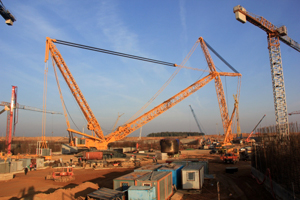Ru
|
Eng
Belarus’ most powerful crane deployed at Belarusian nuclear station construction site
06.11.2014

Belarus’ most powerful hoisting crane has been installed at the construction site of the Belarusian nuclear power plant, BelTA learned from the Information and Public Relations Office of the enterprise Belarusian Nuclear Power Plant.
“A Liebherr 11350 hoisting crane with the lifting capacity of 1,350 tonnes has been installed at the construction site of the Belarusian nuclear power plant. The primary arm of the crane is 72m long while the auxiliary arm is 36m long,” said the source.
The crane uses caterpillar treads and can move as fast as 1.08kmph. The crane will be used to perform lifting and transportation operations with heavy objects and structures, including the installation of the molten core catcher, the reactors, and steam generators.
The crane was delivered to the construction site of the Belarusian nuclear power plant in a completely knocked down state to be then assembled at the construction site of the first power-generating unit.
BelTA has been told that on 5 November the construction workers started concreting operations for the internal protective shell of the building where the reactor of the first power-generating unit will be located. The construction of the internal protective shell began in late August 2014. Now the construction of the Belarusian nuclear power plant is in its aboveground phase.
The internal protective shell is a complex piece of engineering meant to prevent the release of radioactive substances into the environment even in an emergency.
The Belarusian nuclear power plant is being built 18km away from Ostrovets, Grodno Oblast using the AES-2006 design developed by the Saint Petersburg-based R&D company Atomenergoproject. The power plant will have two power-generating units with the total output capacity of up to 2,400MW (2x1,200MW). The Russian merged company OAO NIAEP – ZAO ASE is the general designer and the general contractor of the project. In line with the general contract for building the nuclear power plant the first power-generating unit is scheduled for commissioning in 2018, with the second one to go online in 2020.
“A Liebherr 11350 hoisting crane with the lifting capacity of 1,350 tonnes has been installed at the construction site of the Belarusian nuclear power plant. The primary arm of the crane is 72m long while the auxiliary arm is 36m long,” said the source.
The crane uses caterpillar treads and can move as fast as 1.08kmph. The crane will be used to perform lifting and transportation operations with heavy objects and structures, including the installation of the molten core catcher, the reactors, and steam generators.
The crane was delivered to the construction site of the Belarusian nuclear power plant in a completely knocked down state to be then assembled at the construction site of the first power-generating unit.
BelTA has been told that on 5 November the construction workers started concreting operations for the internal protective shell of the building where the reactor of the first power-generating unit will be located. The construction of the internal protective shell began in late August 2014. Now the construction of the Belarusian nuclear power plant is in its aboveground phase.
The internal protective shell is a complex piece of engineering meant to prevent the release of radioactive substances into the environment even in an emergency.
The Belarusian nuclear power plant is being built 18km away from Ostrovets, Grodno Oblast using the AES-2006 design developed by the Saint Petersburg-based R&D company Atomenergoproject. The power plant will have two power-generating units with the total output capacity of up to 2,400MW (2x1,200MW). The Russian merged company OAO NIAEP – ZAO ASE is the general designer and the general contractor of the project. In line with the general contract for building the nuclear power plant the first power-generating unit is scheduled for commissioning in 2018, with the second one to go online in 2020.
BELNPP: NEWS FROM CONSTRUCTION SITE
23.07.2024
11.07.2024
28.06.2024
06.06.2024
04.06.2024
04.06.2024
03.06.2024
24.05.2024
23.05.2024
03.05.2024













